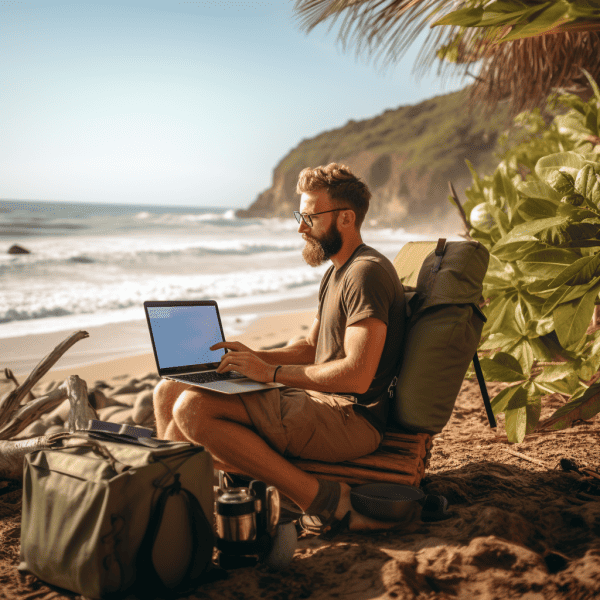As someone who left behind traditional life to become a digital nomad years ago, I’m often asked – how much does the nomad lifestyle cost? The answer isn’t straightforward, since expenses vary dramatically based on your goals and choices. My own costs have evolved over the years.
I’ll never forget when I took the leap and went nomadic, selling most possessions and budgeting barebones to make ends meet. Renting barebones rooms and cooking simple meals, I managed to get by on about $1000 a month in cheaper countries. It required frugal dedication!
Now, I aim for a balance of affordability and comfort when planning my nomad budget. I’ve learned how to maximize value from accommodation through rentals and work trades. And I indulge in delicious local food while also cooking plenty. Ultimately, you craft the lifestyle you want.
From backpacker hostels to luxury resorts, how you want to live and where determines your nomad costs. But freedom and fulfillment don’t have to break the bank. Read on for tips on choosing your ideal nomadic budget and lifestyle. I’ll share what I’ve learned.
KEY TAKEAWAY
Digital nomad lifestyle cost, what should you know?
Living a nomadic lifestyle can offer freedom and flexibility, but it also requires careful budgeting and financial planning. Understanding the costs associated with accommodation, transportation, meals, and other expenses is crucial for successfully sustaining a nomadic lifestyle (1).
Calculating the Cost of a Nomad Lifestyle
Becoming a digital nomad offers the freedom and flexibility to live and work while traveling the globe. But determining if you can realistically afford this non-traditional lifestyle involves looking at costs.
Expenses like lodging, food, activities, transportation, gear, and more add up. With good budgeting, prioritization, and deal-seeking, a nomad life can be affordable for many. But understanding common costs helps set realistic expectations.
Ideally, start with at least 6 months of living expenses saved up before making the nomad leap. Having a financial cushion prevents stress when launching into the unknown. Ongoing frugality and money management keep costs down.
Let’s explore typical digital nomad expenditures across categories so you can begin mapping out your ideal budget and lifestyle vision. Cost should never be the sole factor – focus on chasing purpose above all else.
Monthly Essentials: Budgeting for Basic Needs

When budgeting as a digital nomad, monthly essential living costs will likely be your largest expense. How lavishly you want to live determines budgets.
Housing, food, transportation, and basic necessities make up these fixed monthly costs. Private apartment rentals, rideshares, and eating out constantly pile up fast. Budget bunk beds, walking, and cooking leanly saves enormously.
Many nomads spend around $1000-1500 monthly for reasonably comfortable lifestyles in affordable regions like Southeast Asia or Eastern Europe. But frugal living can lower costs to $800 or well below. Make your own priorities (z).
Building a community and splitting costs with others helps tremendously too. Get creative collaborating! With mindfulness, the monthly basics need not break the bank.
Recurring Expenses: Beyond the Basics

In addition to essential monthly expenses, some costs recur periodically during travels. These include health insurance, cell phone bills, subscriptions, and other lifestyle expenses.
Health insurance pricing varies greatly based on plan, deductibles, and country. Budget $100-500 monthly for a travel policy that ensures you’re covered in emergencies abroad. This is non-negotiable!
Unlocked cell phones with local SIM cards offer affordable long-term phone access around $10-30 monthly in many places. International plans or roaming jack up costs exponentially.
Planning for Non-Monthly Expenses
While essentials make up the bulk of a nomad’s budget, some costs only come up occasionally yet still require planning for. Saving towards these expenses ensures they don’t derail your journey.
Long-term world travelers need to budget for periodic flights between regions and continents to experience new cultures and places. Depending on distance, flights run $200-$1000.
Visa fees also vary widely by country, from $0 to over $200. Multiply by how often you need to exit and re-enter countries annually. Staying put saves costs.
Major gear like phones, laptops, cameras, luggage, etc. need replacing every few years. Budgeting a monthly amount towards these big purchases helps even out costs.
Lastly, build in emergency savings each month in case of theft, medical issues, or other crises. Having a buffer for the unexpected prevents desperate situations.
While not monthly, these longer-term nomad costs need consideration so they don’t suddenly upend budgets down the road. Plan ahead!
Exploring Optional Expenses as a Nomad
One advantage of the nomad lifestyle is choosing what optional expenses fit your interests and values. You craft the experience you want.
Some nomads focus on cultural learning, taking language classes or booking educational tours on arrival somewhere new. These enriching additions run $50-500+ monthly.
Others prefer living luxuriously, staying in high-end boutique hotels and dining at Michelin-rated restaurants regularly, which can mean $5000+ monthly budgets.
Many seek balance, indulging in some comforts and gourmet meals while also living modestly day-to-day. Look for deals, travel off-season, and learn to cook local cuisine and you can have the best of both worlds!
There are infinite ways to shape your nomadic experience. Ignore social media-hyped ideals. Craft the version that feels authentically fulfilling, then budget accordingly.
Budgeting for Different Regions and Countries
One major factor that will impact costs is which part of the world you travel in. Certain regions and countries are far more budget-friendly for nomads than others.
Southeast Asia and South America both offer lots of bang for your buck. Many cities in Thailand, Vietnam, Peru, Ecuador can be quite comfortable on $1000 monthly. Eastern Europe also boasts deals.
Western Europe, Australia, the US, and Canada all generally have high costs of living and transportation that make travel more expensive. Budget at least $2000+ monthly.
Before plotting your nomadic route, research average costs in various destinations so you can set realistic budgets. And don’t be afraid to spend longer stints in affordable places.
No matter where you go, avoiding tourist traps, eating local cuisine, and living like a resident saves tremendously compared to vacationers. Seek out deals!
Financial Considerations for Starting a Nomadic Life
Before taking the plunge into nomadic living, make sure your finances are in order. Saving an emergency fund and aligning income streams takes planning.
Ideally have 6 months of living expenses banked as a cushion. And line up remote work or freelancing to reliably fund your travels long-term. Having income and savings prevents scrambling.
Eliminate unnecessary expenses and liabilities before departing so your money goes towards the lifestyle directly. For big trip expenses, use credit card points you’ve earned.
Moving from a stable location to nomadic living has challenges. But with prudent preparation, you can make the finances work to fund the purpose-driven lifestyle you crave!
Practical Tips to Manage Costs and Savings as a Nomad
Beyond budgeting, nomads use many practical tricks to keep costs affordable without sacrificing an exciting experience. Here are some of my favorites:
- Seek long-term rentals or work exchanges for free/discounted accommodation
- Cook bulk meals and limit eating out to special occasions
- Stick to carry-on luggage only to avoid fees
- Walk, bike, or use public transit instead of rideshares/taxis
- Avoid activities and destinations during high season peak times
- Take overnight buses or trains on longer transit days to save a night’s lodging
- Use travel hacking techniques to get deals on flights and hotels
- Bond with other nomads to share costs and knowledge
With creativity and compromise, the nomadic life can work on almost any budget. Focus on chasing fulfillment and adventure over material comforts!
Optimizing Taxes as a Digital Nomad
As a nomad with income streams like freelancing or a remote job, also learn how taxes work abroad so you don’t overpay. Be strategic:
- Check if countries you travel in have tax treaties with your home country
- Spend over 6 months in low-tax countries to become a non-resident
- Save receipts for deductions like travel expenses or coworking spaces
- Invest in tax software that works for nomads and auto-imports documents
- Hire an accountant knowledgeable about expat/nomad tax issues
With the right information, you can navigate taxes smoothly. Don’t let it deter you from the nomadic path!
For more preparation tips for digital nomad, you can read it in the link.
Conclusion
In closing, the digital nomad life can span a wide spectrum of budgets depending on the experience you want. With mindful spending, splitting costs, and seeking deals, you may be surprised how affordable living a location-independent lifestyle can be.
Focus less on maintaining luxuries, and more on needs versus wants. Seek opportunities to exchange work for accommodation. Take advantage of cheaper destinations. And build a community to share costs and experiences.
Where there’s a will, there’s a way. If living freely and adventuring aligns with your values, you can craft an incredible nomadic journey at almost any budget. Just get creative! The purpose-driven lifestyle pays dividends beyond money.
If you seek more guide about digital nomad, then you can check this out.
References
- https://citizenremote.com/blog/digital-nomad-salaries-in-2023/#:~:text=It%20depends%20on%20the%20area,is%20between%20%241000%20and%20%242000.
- https://www.nerdwallet.com/article/finance/how-to-budget#:~:text=Get%20started-,Allow%20up%20to%2050%25%20of%20your%20income%20for%20needs,Basic%20utilities.
Related Articles
- https://timecurvesoft.com/guide-to-digital-nomad/
- https://timecurvesoft.com/digital-nomad-getting-started-planning/
- https://timecurvesoft.com/disadvantages-of-living-in-a-digital-world/
Was this helpful?

Stephanie Ansel is a well-known writer and journalist known for her unique and captivating writing style. She has written many articles and books on important topics such as the lifestyle, environment, hobbies, and technology and has been published in some of the biggest newspapers and magazines. Stephanie is also a friendly and approachable person who loves to talk to people and learn about their stories. Her writing is easy to read and understand, filled with lots of details and information, and is perfect for both kids and adults who want to learn about important topics in an interesting way.

